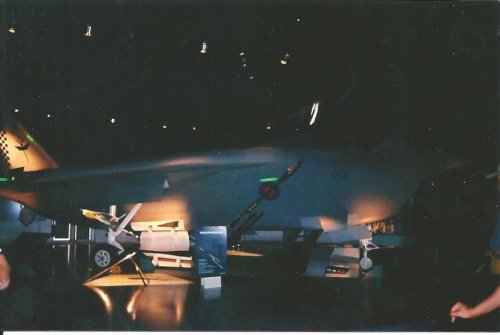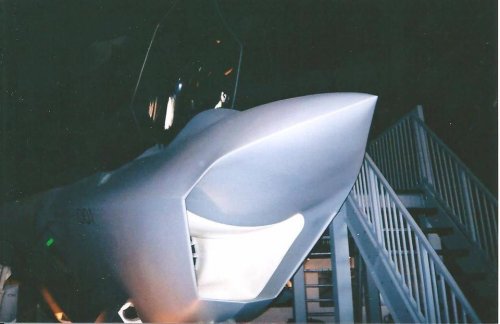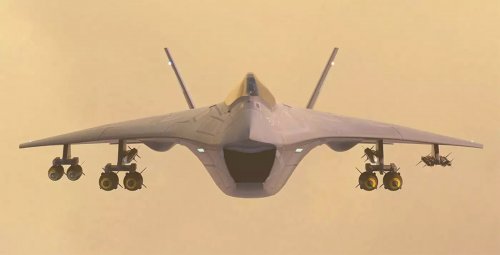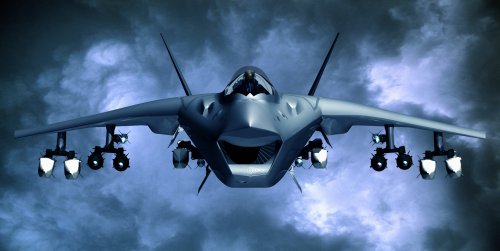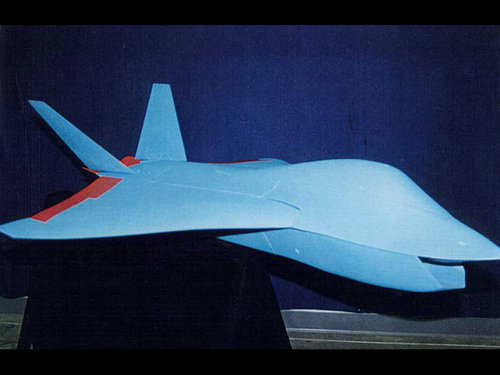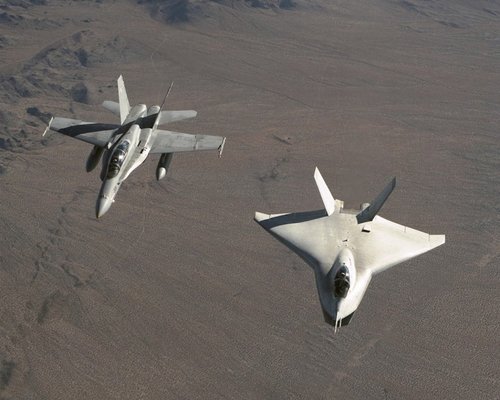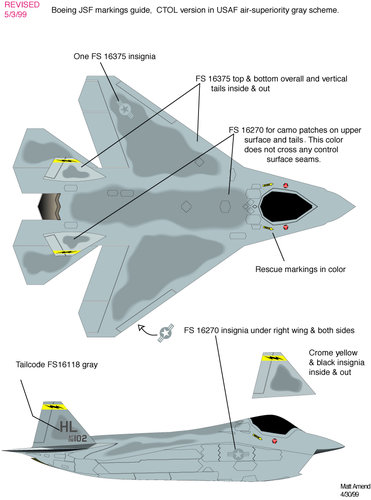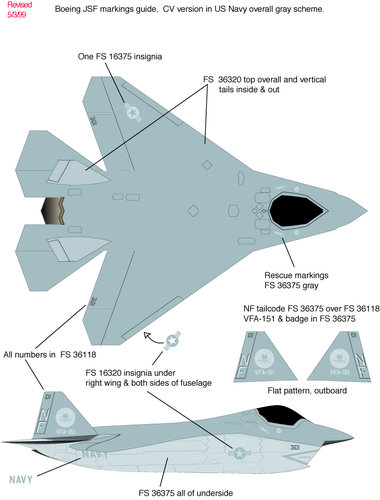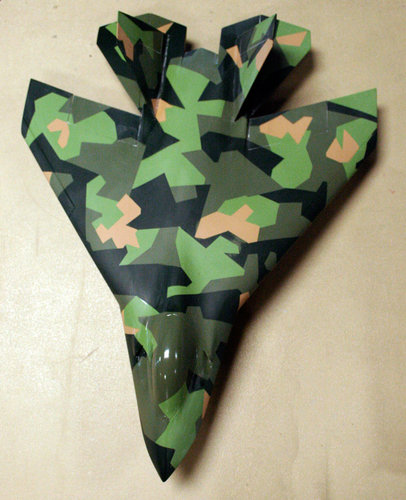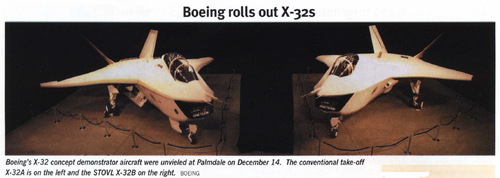You are using an out of date browser. It may not display this or other websites correctly.
You should upgrade or use an alternative browser.
You should upgrade or use an alternative browser.
Boeing JAST / JSF / X-32 /PWSC F-32 projects
- Thread starter Archibald
- Start date
RavenOne
ACCESS: Top Secret
- Joined
- 18 June 2008
- Messages
- 1,000
- Reaction score
- 2,656
Here are my photos of the X-32 mock up in Royal Navy Fleet Air Arm markings @Paris Airshow 2001.
My thoughts are that it is not that un unattractive , have seen worse.
If it was picked , judging by its size - an LHA or our QE2 could accomodate more / more space in hangar?
For the USAF and NATO air arms, for its szie could it not be suited for the European theater, potentially operating off say the autobahns, unpaved strips in the middle of the woods like the Harrier GR7/GR9/a?
Any thoughts here?
Cheers
My thoughts are that it is not that un unattractive , have seen worse.
If it was picked , judging by its size - an LHA or our QE2 could accomodate more / more space in hangar?
For the USAF and NATO air arms, for its szie could it not be suited for the European theater, potentially operating off say the autobahns, unpaved strips in the middle of the woods like the Harrier GR7/GR9/a?
Any thoughts here?
Cheers
Attachments
I wonder what happened to that mock up?
Does anyone know what the manufacturer's construction numbers were for the two X-32 prototypes? Also, were they assigned military serial numbers or did they have civil registrations? I can't seem to find any information.
Some very flattering F-32 artwork by Adam Burch of hangar-b.com can be seen at the following links -
http://www.thedrive.com/the-war-zone/20971/this-is-what-a-boeing-f-32-wouldve-looked-like-if-lockheed-lost-the-jsf-competition
https://fineartamerica.com/art/digital+art/f-32
Like the F-117 the X-32/F-32 could look bulky or sleek depending on which angle you saw it from. I always liked it anyway.
http://www.thedrive.com/the-war-zone/20971/this-is-what-a-boeing-f-32-wouldve-looked-like-if-lockheed-lost-the-jsf-competition
https://fineartamerica.com/art/digital+art/f-32
Like the F-117 the X-32/F-32 could look bulky or sleek depending on which angle you saw it from. I always liked it anyway.
ScrutorAudax
ACCESS: Confidential
- Joined
- 4 June 2015
- Messages
- 66
- Reaction score
- 99
Does anyone know where the X-32 mock-up(s) currently reside?
- Joined
- 29 July 2009
- Messages
- 1,766
- Reaction score
- 2,453
I just saw the X-32B outside of the museum at the Patuxent Naval Air Museum in Maryland a couple of weeks ago. The X-32A is at the USAF Museum in Dayton. However, I don't know where the X-32 mockup is...possibly Palmdale where the Boeing X-32 construction took place.
Last edited:
ScrutorAudax
ACCESS: Confidential
- Joined
- 4 June 2015
- Messages
- 66
- Reaction score
- 99
Stratodesigner
I really should change my personal text
- Joined
- 4 August 2014
- Messages
- 24
- Reaction score
- 23
I have been looking at this design lately as a basis for my paper airplane designs. The chin intake really spoils the looks of this compact and innovative design.
Has no-one seen the similarity to the Northrop N-102 Fang design from the 1950s? Another compact design that lost out on range due to the inefficiency of the delta wing.

 hushkit.net
hushkit.net
Compared to the AV 8B, the X-32 is a much heavier aircraft, with an empty weight of 10,000 kg compared to the AV 8 B weight of 6,000 kg empty. A huge engine was required, which in turn would need more fuel.
If Boeing was going to lose anyway they could have stuck with the original proposal and added in-wing electrically operated lift fans like the Ryan Vertijet, cutting into some of that fuel.
Has no-one seen the similarity to the Northrop N-102 Fang design from the 1950s? Another compact design that lost out on range due to the inefficiency of the delta wing.

The Northrop N-102 Fang fighter
Jim Smith had significant technical roles in the development of the UK’s leading military aviation programmes. From ASRAAM and Nimrod, to the JSF and Eurofighter Typhoon. We asked his opinion on wh…
Compared to the AV 8B, the X-32 is a much heavier aircraft, with an empty weight of 10,000 kg compared to the AV 8 B weight of 6,000 kg empty. A huge engine was required, which in turn would need more fuel.
If Boeing was going to lose anyway they could have stuck with the original proposal and added in-wing electrically operated lift fans like the Ryan Vertijet, cutting into some of that fuel.
- Joined
- 24 November 2008
- Messages
- 1,547
- Reaction score
- 2,599
Attachments
taildragger
You can count on me - I won a contest
- Joined
- 2 November 2008
- Messages
- 403
- Reaction score
- 499
I have been looking at this design lately as a basis for my paper airplane designs. The chin intake really spoils the looks of this compact and innovative design.
Has no-one seen the similarity to the Northrop N-102 Fang design from the 1950s? Another compact design that lost out on range due to the inefficiency of the delta wing.
Compared to the AV 8B, the X-32 is a much heavier aircraft, with an empty weight of 10,000 kg compared to the AV 8 B weight of 6,000 kg empty. A huge engine was required, which in turn would need more fuel.
If Boeing was going to lose anyway they could have stuck with the original proposal and added in-wing electrically operated lift fans like the Ryan Vertijet, cutting into some of that fuel.
Boeing's final proposal abandoned the delta wing and adopted a low aspect ratio swept wing with a conventional tail. In-wing fans, in conjunction with the vectored thrust nozzles, would have paced the center of VTOL lift in the wrong location.
The Northrop N-102 Fang fighter
Jim Smith had significant technical roles in the development of the UK’s leading military aviation programmes. From ASRAAM and Nimrod, to the JSF and Eurofighter Typhoon. We asked his opinion on wh…hushkit.net
Purpletrouble
ACCESS: Secret
- Joined
- 16 September 2019
- Messages
- 449
- Reaction score
- 420
JSF/F35 was centre of my world for quite a few years SDD and later. Prior to that the history I was told was JSF’s end point was effectively fixed back in the early 90s when it was Macair vs LM. Both got contracts to look at lift fans, former gas driven (piping bleed air forward out of fan tips) and latter shaft driven.
Result was shaft driven was much better, the piping occupied huge amounts of volume, if that is the gearbox could work on the shaft driven one. LM gained all the relevant expertise and patented a few aspects, so when it came to JSF they went with that and Macair had to knowingly go backwards with lift engines which they knew were an inferior concept.
JSF was however all about affordability (until SDD go going...) and Boeing scored very high on costs and confidence they’d deliver. Macair didn’t.
At the down select LM went through, Boeing‘s thing then wasn’t liked but they had the “deliver” side covered. Macair out in cold with a known subpar concept and linked to MD11 going nowhere got swallowed up.
Macair engineers got pulled onto the X32 and the phrase for what they found was “voodoo engineering”. Boeing had little experience and simply didnt know about many STOVL issues, hot gas ingestion, inlet and jet effects the key ones that massively affect the performance of the design.
Most quit as Boeing didn’t like being told the design was awful, and only listened when it had no choice - the bleed air “screen” added under the intake to (inneffectively) try and stop nozzle hot air being sucked in one of the few that did.
And yet, at the annual STOVL conferences in this period to the final selection, X32 got voted every time as the likely winner. Boeing’s industrial expertise and Macair STOVL seen as a winning combination, although not working in reality.
In the trials X32 could barely hover, and even then the strip of the ac was extensive, for a non service life “light” structure, and it clearly had no potential.
X35 on the other hand soared, more than hoped in fact!
Of course LM did what they were expected to do, go vastly over budget and time and the ac got fat in the process. Boeing may have avoided that but then looking at its Dreamliner / 737MAX travails their management haven’t been noticeably better.
Result was shaft driven was much better, the piping occupied huge amounts of volume, if that is the gearbox could work on the shaft driven one. LM gained all the relevant expertise and patented a few aspects, so when it came to JSF they went with that and Macair had to knowingly go backwards with lift engines which they knew were an inferior concept.
JSF was however all about affordability (until SDD go going...) and Boeing scored very high on costs and confidence they’d deliver. Macair didn’t.
At the down select LM went through, Boeing‘s thing then wasn’t liked but they had the “deliver” side covered. Macair out in cold with a known subpar concept and linked to MD11 going nowhere got swallowed up.
Macair engineers got pulled onto the X32 and the phrase for what they found was “voodoo engineering”. Boeing had little experience and simply didnt know about many STOVL issues, hot gas ingestion, inlet and jet effects the key ones that massively affect the performance of the design.
Most quit as Boeing didn’t like being told the design was awful, and only listened when it had no choice - the bleed air “screen” added under the intake to (inneffectively) try and stop nozzle hot air being sucked in one of the few that did.
And yet, at the annual STOVL conferences in this period to the final selection, X32 got voted every time as the likely winner. Boeing’s industrial expertise and Macair STOVL seen as a winning combination, although not working in reality.
In the trials X32 could barely hover, and even then the strip of the ac was extensive, for a non service life “light” structure, and it clearly had no potential.
X35 on the other hand soared, more than hoped in fact!
Of course LM did what they were expected to do, go vastly over budget and time and the ac got fat in the process. Boeing may have avoided that but then looking at its Dreamliner / 737MAX travails their management haven’t been noticeably better.
Raberto
Patiently awaiting RQ-180 revelations...
- Joined
- 28 September 2017
- Messages
- 46
- Reaction score
- 68
Haha I remember the head honcho using this term when referring to Boeing's entry when I worked on F-35 at BAE Samlesbury back in the early 2000's =)
- Joined
- 2 August 2006
- Messages
- 3,253
- Reaction score
- 1,518
JSF/F35 was centre of my world for quite a few years SDD and later. Prior to that the history I was told was JSF’s end point was effectively fixed back in the early 90s when it was Macair vs LM. Both got contracts to look at lift fans, former gas driven (piping bleed air forward out of fan tips) and latter shaft driven.
Result was shaft driven was much better, the piping occupied huge amounts of volume, if that is the gearbox could work on the shaft driven one. LM gained all the relevant expertise and patented a few aspects, so when it came to JSF they went with that and Macair had to knowingly go backwards with lift engines which they knew were an inferior concept.
JSF was however all about affordability (until SDD go going...) and Boeing scored very high on costs and confidence they’d deliver. Macair didn’t.
At the down select LM went through, Boeing‘s thing then wasn’t liked but they had the “deliver” side covered. Macair out in cold with a known subpar concept and linked to MD11 going nowhere got swallowed up.
Macair engineers got pulled onto the X32 and the phrase for what they found was “voodoo engineering”. Boeing had little experience and simply didnt know about many STOVL issues, hot gas ingestion, inlet and jet effects the key ones that massively affect the performance of the design.
Most quit as Boeing didn’t like being told the design was awful, and only listened when it had no choice - the bleed air “screen” added under the intake to (inneffectively) try and stop nozzle hot air being sucked in one of the few that did.
And yet, at the annual STOVL conferences in this period to the final selection, X32 got voted every time as the likely winner. Boeing’s industrial expertise and Macair STOVL seen as a winning combination, although not working in reality.
In the trials X32 could barely hover, and even then the strip of the ac was extensive, for a non service life “light” structure, and it clearly had no potential.
X35 on the other hand soared, more than hoped in fact!
Of course LM did what they were expected to do, go vastly over budget and time and the ac got fat in the process. Boeing may have avoided that but then looking at its Dreamliner / 737MAX travails their management haven’t been noticeably better.
What's your source for this, because most of it, honestly, sounds like crap. Many of the people I went to school with went to work there and they all understood hot gas re-ingestion, both from our air breathing propulsion classes and STOVL aerodynamic courses. Also, they, McAir, had a lot of experience with the AV-8B.
I wonder if those schemes show earlier wing designs? CTOL doesn't have ailerons and CV ailerons aren't full span in other illustrations.Schemes from a Boeing model shop document.
- Joined
- 16 April 2008
- Messages
- 9,572
- Reaction score
- 14,378
JSF/F35 was centre of my world for quite a few years SDD and later. Prior to that the history I was told was JSF’s end point was effectively fixed back in the early 90s when it was Macair vs LM. Both got contracts to look at lift fans, former gas driven (piping bleed air forward out of fan tips) and latter shaft driven.
Result was shaft driven was much better, the piping occupied huge amounts of volume, if that is the gearbox could work on the shaft driven one. LM gained all the relevant expertise and patented a few aspects, so when it came to JSF they went with that and Macair had to knowingly go backwards with lift engines which they knew were an inferior concept.
JSF was however all about affordability (until SDD go going...) and Boeing scored very high on costs and confidence they’d deliver. Macair didn’t.
At the down select LM went through, Boeing‘s thing then wasn’t liked but they had the “deliver” side covered. Macair out in cold with a known subpar concept and linked to MD11 going nowhere got swallowed up.
Macair engineers got pulled onto the X32 and the phrase for what they found was “voodoo engineering”. Boeing had little experience and simply didnt know about many STOVL issues, hot gas ingestion, inlet and jet effects the key ones that massively affect the performance of the design.
Most quit as Boeing didn’t like being told the design was awful, and only listened when it had no choice - the bleed air “screen” added under the intake to (inneffectively) try and stop nozzle hot air being sucked in one of the few that did.
And yet, at the annual STOVL conferences in this period to the final selection, X32 got voted every time as the likely winner. Boeing’s industrial expertise and Macair STOVL seen as a winning combination, although not working in reality.
In the trials X32 could barely hover, and even then the strip of the ac was extensive, for a non service life “light” structure, and it clearly had no potential.
X35 on the other hand soared, more than hoped in fact!
Of course LM did what they were expected to do, go vastly over budget and time and the ac got fat in the process. Boeing may have avoided that but then looking at its Dreamliner / 737MAX travails their management haven’t been noticeably better.
What's your source for this, because most of it, honestly, sounds like crap. Many of the people I went to school with went to work there and they all understood hot gas re-ingestion, both from our air breathing propulsion classes and STOVL aerodynamic courses. Also, they, McAir, had a lot of experience with the AV-8B.
Remember that McAir wasn't part of Boeing until August 1997, about 10 months after the JSF downselect for SDD in November 1996. And of course, while the formal merger was in August, it took time to integrate after that. So Boeing did not really have McAir's AV-8B experience to draw on until about a year into the SDD process, say late 1997/early 1998. I think the former McAir team weighed in on the change from the original X-32 big delta wing to the Preferred Weapon System configuration with the conventional tail surfaces, which was an attempt to fix the original X-32 aero configuration that was not delivering the necessary performance. That was very contentious internally, I understand. And I'd not be at all surprised to hear that Boeing Seattle was pushing back on any critical comments about the propulsion systems, which were very much Boeing's baby.
red admiral
ACCESS: Top Secret
- Joined
- 16 September 2006
- Messages
- 1,792
- Reaction score
- 2,340
In the trials X32 could barely hover, and even then the strip of the ac was extensive, for a non service life “light” structure, and it clearly had no potential.
X35 on the other hand soared, more than hoped in fact!
But X-35 didn't have features like weapon bays...making it rather easier. Not that that makes X-32 any better.
Looking back, I'm not convinced a supersonic, stealthy, STOVL fighter with reasonable payload using direct lift is actually viable. Too many things want to be at the cg.
kaiserd
I really should change my personal text
- Joined
- 25 October 2013
- Messages
- 1,659
- Reaction score
- 1,724
In the trials X32 could barely hover, and even then the strip of the ac was extensive, for a non service life “light” structure, and it clearly had no potential.
X35 on the other hand soared, more than hoped in fact!
But X-35 didn't have features like weapon bays...making it rather easier. Not that that makes X-32 any better.
Looking back, I'm not convinced a supersonic, stealthy, STOVL fighter with reasonable payload using direct lift is actually viable. Too many things want to be at the cg.
Maybe I’m missing something - doesn’t that describe the F-35B which is all of those things?
They were primarily paint and marking guides for the folks in the model shop. I also have the markings only designs for Italy and the UK, I'll dig them up and post them.I wonder if those schemes show earlier wing designs? CTOL doesn't have ailerons and CV ailerons aren't full span in other illustrations.Schemes from a Boeing model shop document.
Just for fun here's a 1/40 model shop casting that a former shop employee was painting up in Swedish splinter. It was never completed as unfortunately he died at far too young age from lung cancer, he was a lifelong non-smoker which made it more tragic.
Attachments
Last edited:
- Joined
- 2 August 2006
- Messages
- 3,253
- Reaction score
- 1,518
Remember that McAir wasn't part of Boeing until August 1997, about 10 months after the JSF downselect for SDD in November 1996. And of course, while the formal merger was in August, it took time to integrate after that. So Boeing did not really have McAir's AV-8B experience to draw on until about a year into the SDD process, say late 1997/early 1998. I think the former McAir team weighed in on the change from the original X-32 big delta wing to the Preferred Weapon System configuration with the conventional tail surfaces, which was an attempt to fix the original X-32 aero configuration that was not delivering the necessary performance. That was very contentious internally, I understand. And I'd not be at all surprised to hear that Boeing Seattle was pushing back on any critical comments about the propulsion systems, which were very much Boeing's baby.
OK, now this is making sense, as I had forgotten that the X-32 was a pure Boeing design. I hadn't realized they forced it on Macair. Macair was originally tied in with the BAe/Northrop design, weren't they?
- Joined
- 16 April 2008
- Messages
- 9,572
- Reaction score
- 14,378
OK, now this is making sense, as I had forgotten that the X-32 was a pure Boeing design. I hadn't realized they forced it on Macair. Macair was originally tied in with the BAe/Northrop design, weren't they?
Macair primed the third design with Northrop and BAe as their subs.
Their failure to win one of the SDD contracts led directly to the sale to Boeing.
Last edited:
red admiral
ACCESS: Top Secret
- Joined
- 16 September 2006
- Messages
- 1,792
- Reaction score
- 2,340
Maybe I’m missing something - doesn’t that describe the F-35B which is all of those things?
Augmented thrust in jetborne mode from the lift fan so really you've got a lift + lift/cruise arrangement but with a single engine.
Direct lift e.g. through vectoring, has less propulsive efficiency in jetborne mode so needs a bigger engine, which pushed weapon bays further outboard, which increases wave drag, which needs a bigger engine, which increases mass, which needs a bigger engine etc. It's unclear that this can be met for the JSF requirements set
- Joined
- 3 June 2011
- Messages
- 18,296
- Reaction score
- 12,109
Looking back, I'm not convinced a supersonic, stealthy, STOVL fighter with reasonable payload using direct lift is actually viable. Too many things want to be at the cg.
The F-35B neatly proves the viability. It isn't cheap, but it's certainly viable.
- Joined
- 3 June 2011
- Messages
- 18,296
- Reaction score
- 12,109
Twin tails, speed, maneuverability, sensors, etc. A bit like saying an F-15SA is really an A-6.Still struck by how much the CTOL really is a stealthy A-7, twin tails notwithstanding.
- Joined
- 21 December 2006
- Messages
- 1,241
- Reaction score
- 1,084
STOVL, Supersonics, Stealth. Choose two. LM did!In the trials X32 could barely hover, and even then the strip of the ac was extensive, for a non service life “light” structure, and it clearly had no potential.
X35 on the other hand soared, more than hoped in fact!
But X-35 didn't have features like weapon bays...making it rather easier. Not that that makes X-32 any better.
Looking back, I'm not convinced a supersonic, stealthy, STOVL fighter with reasonable payload using direct lift is actually viable. Too many things want to be at the cg.
Purpletrouble
ACCESS: Secret
- Joined
- 16 September 2019
- Messages
- 449
- Reaction score
- 420
Working for a decade with the people who lived it in the UK and the US whilst being on the same program intimately involved in the STOVL variant myself. It was also taught as the “history” of F35 on several international STOVL technology courses. But you’d have had to attend them yourself, rather than being “at school with people” who did. I believe the older history of gas/shaft driven lift fan work is public and there were (years ago) a lot of images floating on the internet even then.JSF/F35 was centre of my world for quite a few years SDD and later. Prior to that the history I was told was JSF’s end point was effectively fixed back in the early 90s when it was Macair vs LM. Both got contracts to look at lift fans, former gas driven (piping bleed air forward out of fan tips) and latter shaft driven.
Result was shaft driven was much better, the piping occupied huge amounts of volume, if that is the gearbox could work on the shaft driven one. LM gained all the relevant expertise and patented a few aspects, so when it came to JSF they went with that and Macair had to knowingly go backwards with lift engines which they knew were an inferior concept.
JSF was however all about affordability (until SDD go going...) and Boeing scored very high on costs and confidence they’d deliver. Macair didn’t.
At the down select LM went through, Boeing‘s thing then wasn’t liked but they had the “deliver” side covered. Macair out in cold with a known subpar concept and linked to MD11 going nowhere got swallowed up.
Macair engineers got pulled onto the X32 and the phrase for what they found was “voodoo engineering”. Boeing had little experience and simply didnt know about many STOVL issues, hot gas ingestion, inlet and jet effects the key ones that massively affect the performance of the design.
Most quit as Boeing didn’t like being told the design was awful, and only listened when it had no choice - the bleed air “screen” added under the intake to (inneffectively) try and stop nozzle hot air being sucked in one of the few that did.
And yet, at the annual STOVL conferences in this period to the final selection, X32 got voted every time as the likely winner. Boeing’s industrial expertise and Macair STOVL seen as a winning combination, although not working in reality.
In the trials X32 could barely hover, and even then the strip of the ac was extensive, for a non service life “light” structure, and it clearly had no potential.
X35 on the other hand soared, more than hoped in fact!
Of course LM did what they were expected to do, go vastly over budget and time and the ac got fat in the process. Boeing may have avoided that but then looking at its Dreamliner / 737MAX travails their management haven’t been noticeably better.
What's your source for this, because most of it, honestly, sounds like crap. Many of the people I went to school with went to work there and they all understood hot gas re-ingestion, both from our air breathing propulsion classes and STOVL aerodynamic courses. Also, they, McAir, had a lot of experience with the AV-8B.
Understanding what HGI is (and I note you ignored the if not more important inlet and jet effects so presume you dont even know what they are) and accurately accounting for it in design and development are two enormously different things. As the many (10s of) millions spent during F35 SDD showed LM. Fortunately X35 had the potential and LM used the expertise (and DoD had the pockets...!)
The point, if it wasn’t clear enough - was Macair had that experience but Boeing didn’t, and then didn’t listen very well. That’s why X32 failed on basically every STOVL issue.
TomS - your dates are wrong, you’ve confused the concept demonstration phase of LM (incl. BAES as became) vs Boeing (incl MDD) which was from 1996. Downselect to SDD where the X32 proved, to borrow an adjective, absolute “crap”*, was late 2001. Those 5 years were that key period.
Purpletrouble
ACCESS: Secret
- Joined
- 16 September 2019
- Messages
- 449
- Reaction score
- 420
STOVL, Supersonics, Stealth. Choose two. LM did!In the trials X32 could barely hover, and even then the strip of the ac was extensive, for a non service life “light” structure, and it clearly had no potential.
X35 on the other hand soared, more than hoped in fact!
But X-35 didn't have features like weapon bays...making it rather easier. Not that that makes X-32 any better.
Looking back, I'm not convinced a supersonic, stealthy, STOVL fighter with reasonable payload using direct lift is actually viable. Too many things want to be at the cg.
Cost definitely wasn’t chosen despite being the driver at the outset!
Although a lot of fatness came from high commonality requirement subsequently massively relaxed to get weight down as part of SWAT.
Now where had that mistake been made before? F111, P1154...
A12?? yes JSF project was in the ex Avenger building, but that’s about as close to it surely? The F35A most resembles a single engine F22. Which is what LM had always wanted to build and in time honoured contractor fashion, went and did just that
One comment to me from the greatest STOVL engineer I ever worked with was that X/F35s genius was putting the engine where it should be, at the back, and thus getting everything else right layout wise from that. Lift posts are too large/close in and the fan inlet/exhaust not what you want (hence move away from the hood exhaust and bifold door inlet) but the shaft driven lift fan is the only way to get the combination of two thrust posts and mass flow for STOVL whilst minimising frontal intake area to be able to go fast. The internal volume is significant but no less than lift jets and much less than gas driven fan.
I doubt we’ll ever see another STOVL combat aircraft to be honest. F35B is peak until we invent anti grav or something.
Supersonics is overrated, very very rarely used even by supercruise capable F22/Typhoons. For a predominantly attack ac as F35 is (following AV8 and FA18) even less so. Stealth and STOVL being the right choice.
Purpletrouble
ACCESS: Secret
- Joined
- 16 September 2019
- Messages
- 449
- Reaction score
- 420
And BAe jumping to LM, as they had the right to be on any project that went forward (STOVL variant). Interesting choice as a lot had been invested with Macair over the decades and it wasn’t popular at all plus meant “breaking in” to the LM JSF organisation which was in the early days, very very closed.OK, now this is making sense, as I had forgotten that the X-32 was a pure Boeing design. I hadn't realized they forced it on Macair. Macair was originally tied in with the BAe/Northrop design, weren't they?
Macair primed the third design with Northrop and BAe as their subs.
Their failure to win one of the SDD contracts led directly to the sale to Boeing.
Again despite the dogs dinner that X32 proved and in hindsight seemed obvious, the word and widespread industry opinion at the time was Boeing had to have it and the Harrier-esque evolution was the way ahead. Twasn’t thus, LM did a sound job with the X35 and deserve a lot of credit for what they achieved. A lot of $$$ burnt since then, but it costs what it costs and overspend just means you had no idea of money to start with.
- Joined
- 13 June 2007
- Messages
- 2,172
- Reaction score
- 3,070
Looking at what Flateric posted back in #249, Burch is the tailed JSF vs. what looks like earlier delta wing early iteration. Was there a change in anhedral/wing geometry (and inlet configuration) or is it simply the Boeing artwork hides the added horizontal tailplanes?Renderings have some _serious_ problems with Boeing PWSC JSF geometry
Enjoy the Day! Mark
- Joined
- 16 April 2008
- Messages
- 9,572
- Reaction score
- 14,378
TomS - your dates are wrong, you’ve confused the concept demonstration phase of LM (incl. BAES as became) vs Boeing (incl MDD) which was from 1996. Downselect to SDD where the X32 proved, to borrow an adjective, absolute “crap”*, was late 2001. Those 5 years were that key period.
Yeah, I had the phase names/acronyms wrong, but I think I had the players right. Downselect from three concepts (Boeing, MacAir, and LM) to two companies to build actual prototypes (Boeing vs LM) was in 1996. Boeing bought Macair in late 1997. The flying trials were late 2000 to mid 2001 and the selection of X-35 over X-32 was 2001.
I think my point stands, though (and isn't much different from yours.) Macair expertise wasn't even available to Boeing until the X-32 design was fairly far along, a full year after the initial downselect. And then Macair was telling them it was all messed up, which no one in Seattle wanted to hear.
Purpletrouble
ACCESS: Secret
- Joined
- 16 September 2019
- Messages
- 449
- Reaction score
- 420
Quite - although Boeing were going through a huge redesign in this very key couple of years so lots to do and lots of fluidity. I also believe the “aquisition” of Macair staff however started sooner than the takevoer as they didn’t have much to do and the tea leaves were pretty stark.
- Joined
- 2 August 2006
- Messages
- 3,253
- Reaction score
- 1,518
Working for a decade with the people who lived it in the UK and the US whilst being on the same program intimately involved in the STOVL variant myself. It was also taught as the “history” of F35 on several international STOVL technology courses. But you’d have had to attend them yourself, rather than being “at school with people” who did. I believe the older history of gas/shaft driven lift fan work is public and there were (years ago) a lot of images floating on the internet even then.
Understanding what HGI is (and I note you ignored the if not more important inlet and jet effects so presume you dont even know what they are) and accurately accounting for it in design and development are two enormously different things. As the many (10s of) millions spent during F35 SDD showed LM. Fortunately X35 had the potential and LM used the expertise (and DoD had the pockets...!)
The point, if it wasn’t clear enough - was Macair had that experience but Boeing didn’t, and then didn’t listen very well. That’s why X32 failed on basically every STOVL issue.
TomS - your dates are wrong, you’ve confused the concept demonstration phase of LM (incl. BAES as became) vs Boeing (incl MDD) which was from 1996. Downselect to SDD where the X32 proved, to borrow an adjective, absolute “crap”*, was late 2001. Those 5 years were that key period.
FYI, I'm an Aeronautical engineer, so I did "attend" those classes. I was referring to people in those classes "with me" who ended up at MAC. I mainly had forgotten that the X-32 was a Boeing and not a Macair design, hence my shock at the hot gas reingestion issue, which every single engineer who was in our VSTOL aerodynamics course would have known about. So, your presumptions are quite wrong, but you are entitled to your smug bullshit; I sure can't stop you. I didn't mention the plume, etc, because I wasn't interested in getting into the details, but by all means, let's discuss that and ground erosion and ground effects ad infinitum.
Also, a shaft driven fan wasn't the only way to get the propulsion layout of the F-35. A tandem fan could have offered that as well. If you had known as much about STOVL as you proclaim, you probably would have known that. Of course, there would have been problems with the losses at the front fan due to the two ninety degree bends and it wouldn't be able to operate at optimum RPM being directly tied to the powerplant. Of course, it also wouldn't have had as much of a weight penalty since it wouldn't have required the lift fans gear box. I hope I was able to match your level of condescension, so that you may understand what I'm writing.
apparition13
I really should change my personal text
- Joined
- 27 January 2017
- Messages
- 604
- Reaction score
- 1,098
Why hasn't a tandem fan been built? It seems very attractive at a surface level. Vought and BAE both had designs for them.Also, a shaft driven fan wasn't the only way to get the propulsion layout of the F-35. A tandem fan could have offered that as well. If you had known as much about STOVL as you proclaim, you probably would have known that. Of course, there would have been problems with the losses at the front fan due to the two ninety degree bends and it wouldn't be able to operate at optimum RPM being directly tied to the powerplant. Of course, it also wouldn't have had as much of a weight penalty since it wouldn't have required the lift fans gear box.
Similar threads
-
McDD/Northrop/BAe ASTOVL/MRF/JAST/JSF studies
- Started by Antonio
- Replies: 255
-
Alternate history: Boeing won JSF
- Started by helmutkohl
- Replies: 45
-
Boeing Multi-Role Fighter (MRF) studies
- Started by Sundog
- Replies: 39
-
US Navy 1960-1963 VAX supersonic A-4 replacement program
- Started by Skybolt
- Replies: 49
-

